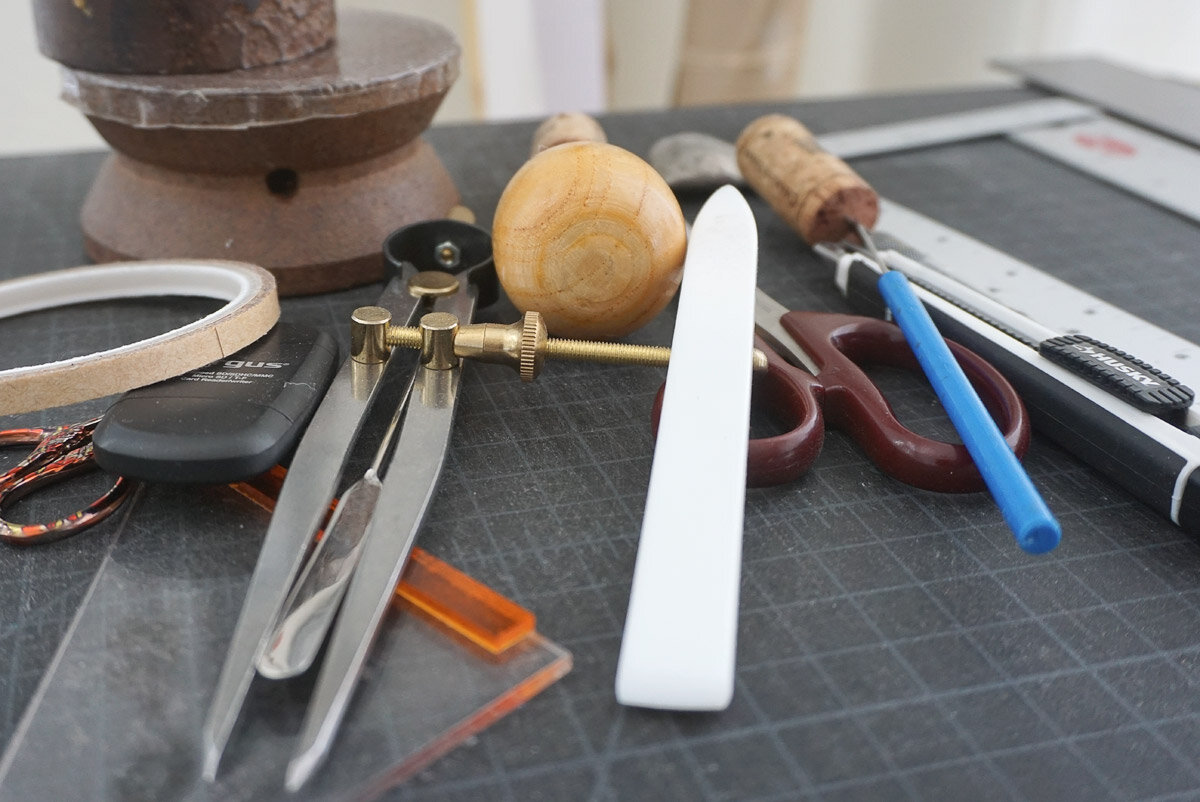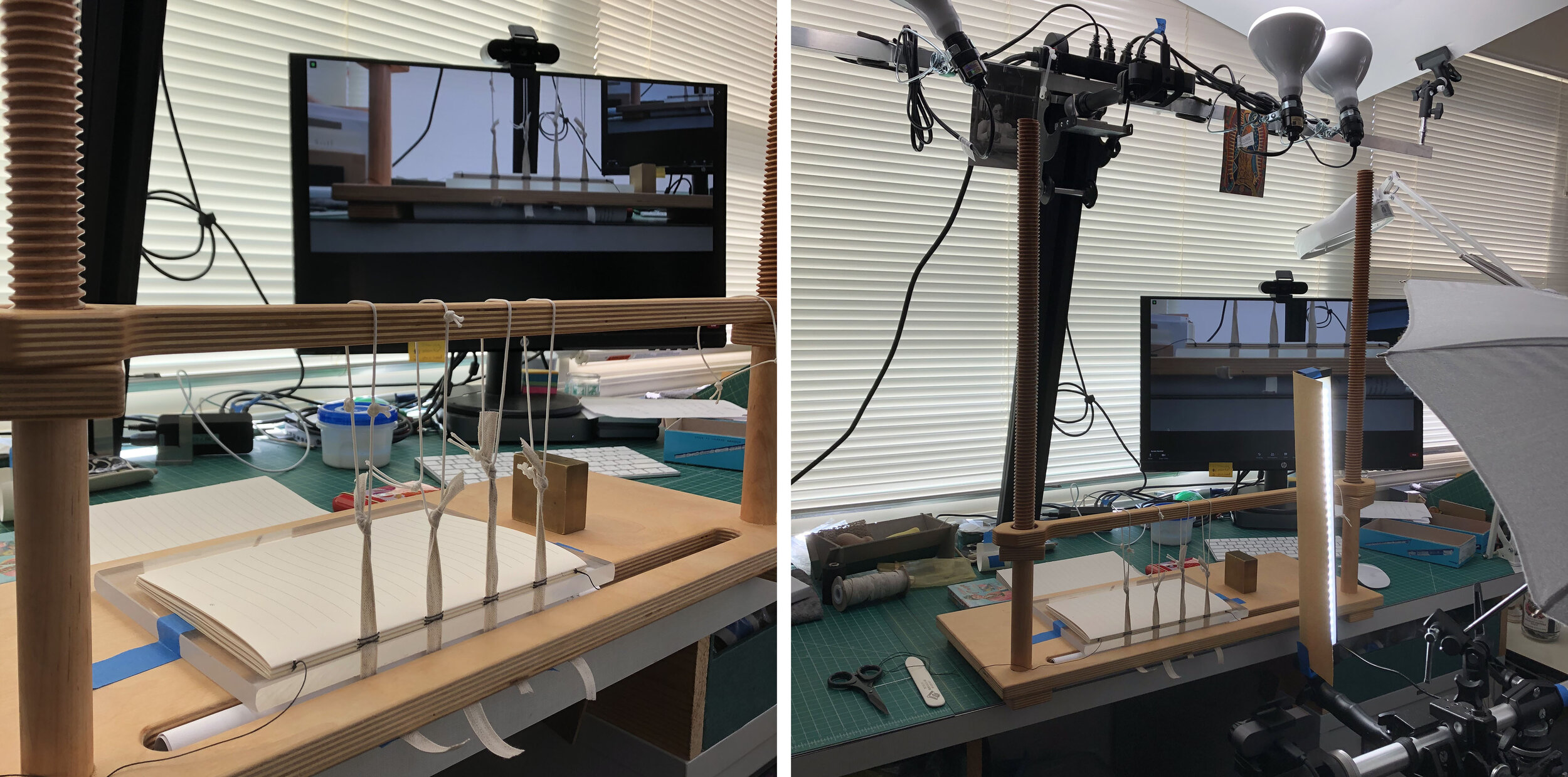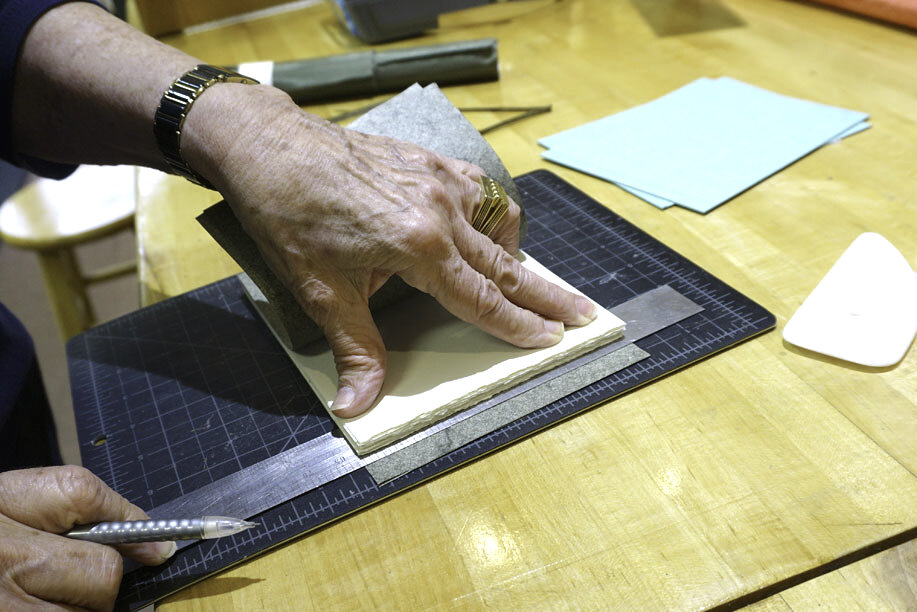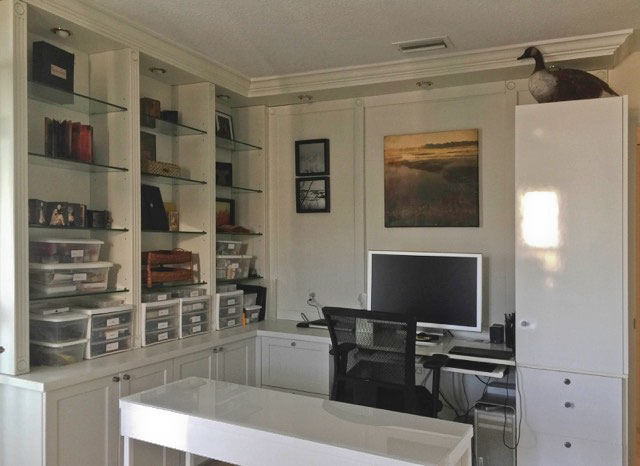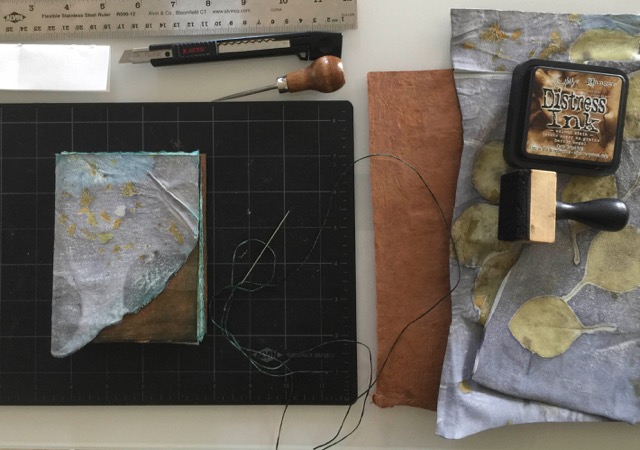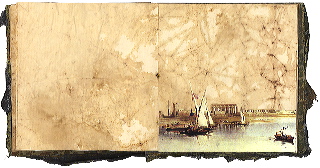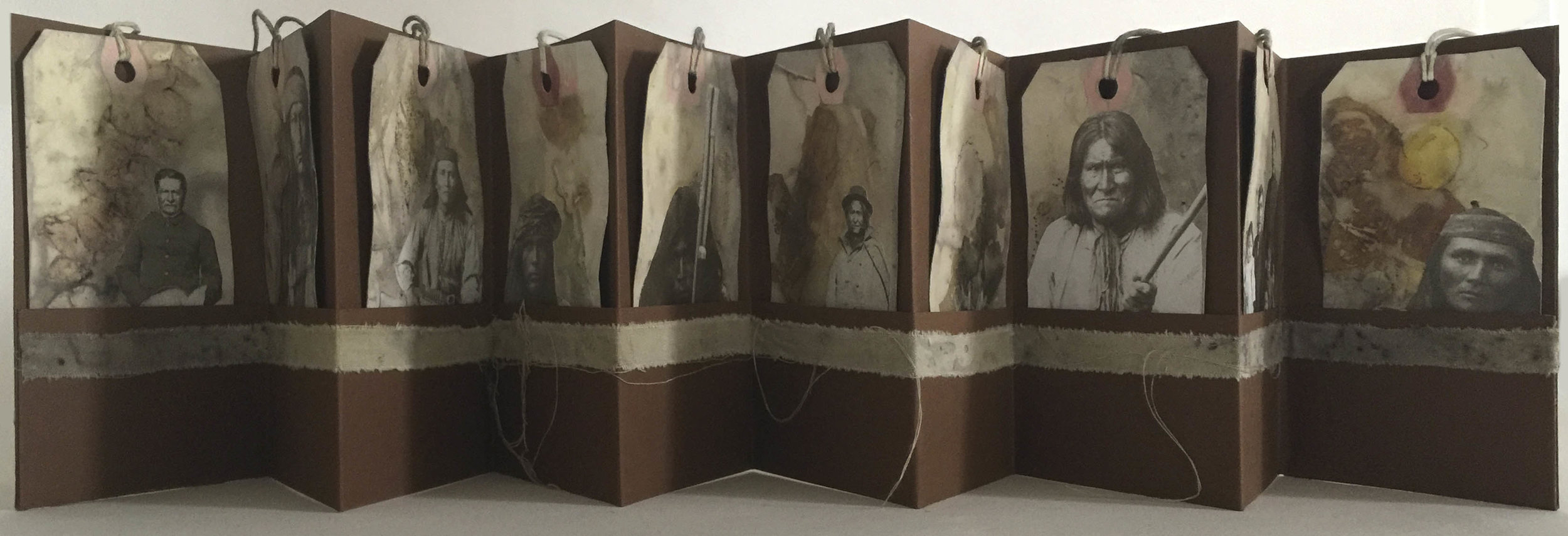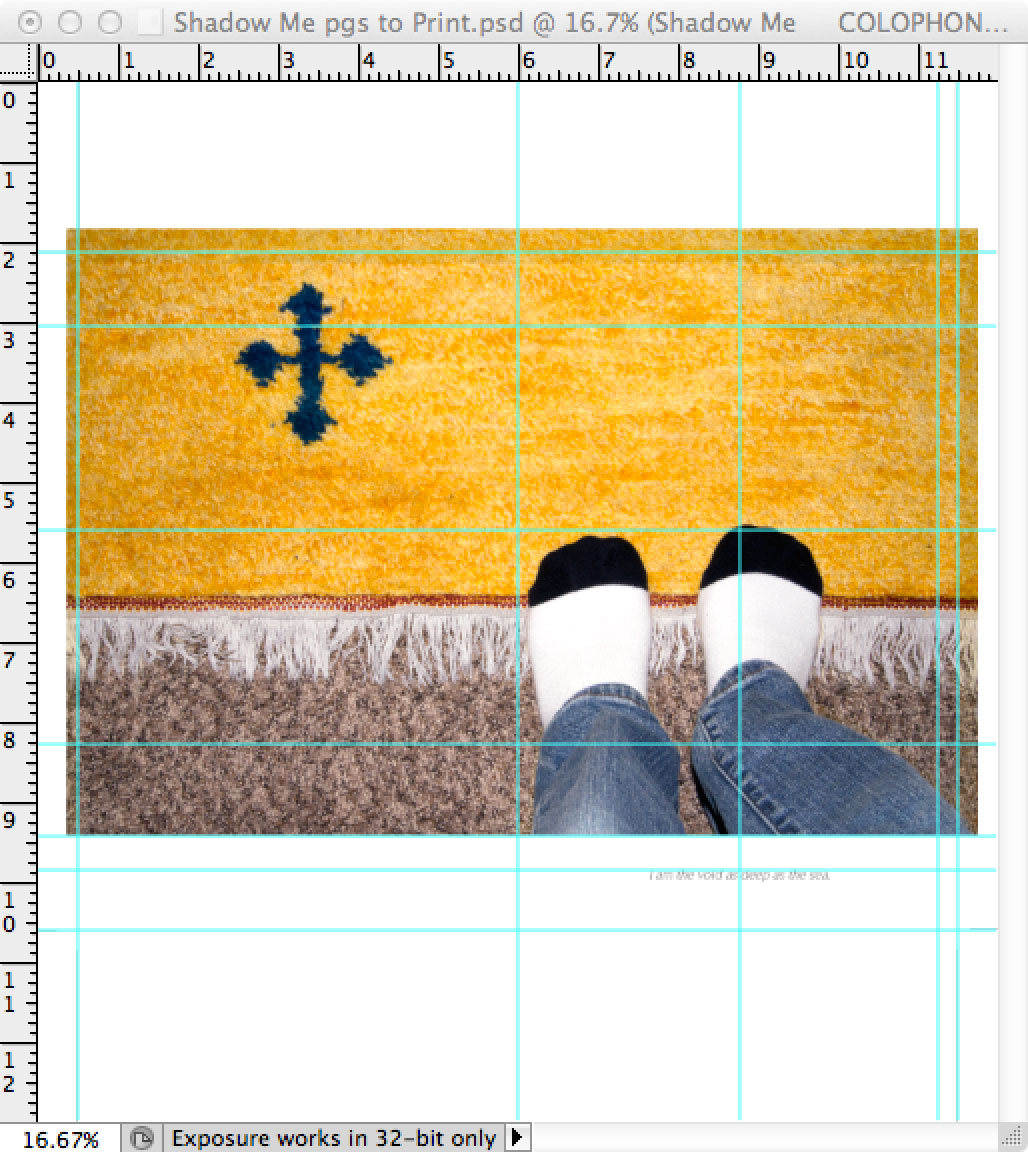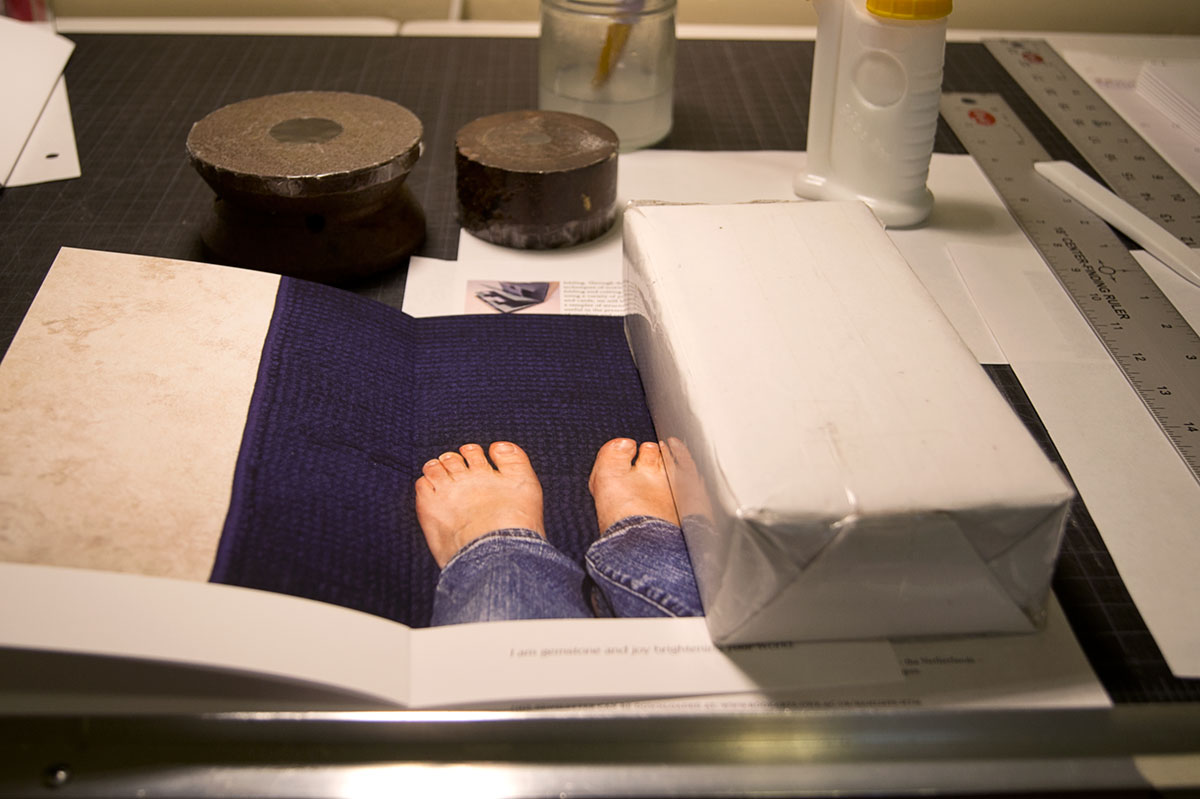I have discussed the subject of doing business a few times on my blog since 2016. In a changing world and reaching retirement age (I dare to talk about it!), revisiting the impact of producing artists’ books and continuing business during this period of my life seemed important. Warning! If you don’t like reading, this post is a long one, but its content might elevate your spirit.
With the unset of the pandemic, most of us were hibernating and deciding to head into our studios and focus on producing new work. For me, the lockdown allowed peaceful time to produce and enjoy my teeny weeny studio in our travel trailer while confined in Arizona at the end of March 2020. After a summer of 55 plus days in 46°C (115°F) and Covid’s long-term existence, we decided to purchase a modest home. This current phase assists my husband and I to be safe, execute our work, and not worry about baking in the sun!
© 2021 Louise Levergneux. Tools of the trade.
Covid presented many economic challenges for us all. Understanding the dilemma of maintaining a profitable business during these tumultuous times was insightful. I asked myself many questions — Why do I produce artists' books? — Is it the desire to express my thoughts, produce something of value, establish a business, or is it absolute joy? Can I manage the necessary materials? Am I destined to accumulate an inventory instead of a sellable product? How do I continue the promotion and distribution of artists' books? How will the libraries actively collect, while closed? Do I stop publishing? Is this a wake-up-call, flagging the end of a career? ...
I was surprised to receive an email through the BookListServ with the subject: Keeping Business Going by John Cutrone. I appreciated someone bringing this matter to the forefront. I responded directly to John’s query as we contemplated the subject together. We both waited for some feedback from other artists on sharing their dilemmas of doing business on the BookListServ. We were both fascinated with the lack of reaction.
In my email to John, I mentioned my struggle to send a prospectus to library contacts at this time. Ultimately, with an optimistic attitude I emailed contacts identifying the sensitivity in which I was sending my prospectus of recent artists’ books created in 2020-2021.
After a couple of days, John responded to my struggle through the BookListServ:
Thank you to Louise Levergneux for the artist-as-businessperson perspective; I appreciate that! I'm going to switch hats from Convivio Bookworks proprietor to Jaffe Center for Book Arts director and say that I don't think that book artists need feel guilty about sending out prospectuses and sales attempts during this pandemic time. For us at the Jaffe Center, we never get an acquisitions budget––we are part of a state university system that is constantly dealing with budget cuts handed down from the state legislature and one of the things to go, back in 2008 or so, was the annual acquisitions budget for Special Collections. Once gone, it never came back. And that's why we have an annual pie sale and other fundraisers.
Thanks to that pie sale and workshops and other perhaps unorthodox methods we've developed to raise money, I am able to buy books and prints from book artists (including many of you on this list), and I was able to do so even when things were looking bleak last spring and summer. I can't ever buy expensive pieces, but I can afford to purchase pieces that are up to a few hundred dollars, and I think supporting artists on a transactional basis like this makes an impact.
So how do you get attention from library collections without in-person events like CODEX these days? Direct mail to collections may not be the best way to go right now. Many, like the Jaffe, are not currently open, so a prospectus sent to a physical library address may go unanswered for weeks or even months. At the same time, emails are easily lost in the avalanche of emails received daily.
I think you have to be persistent if you want to sell your work to collections right now. Emails should be short and sweet, something that can be easily grasped in a few seconds. And while I don't have time to keep up with every contact I follow on Instagram and Facebook, I have made purchases for the Jaffe Collection through these means if something catches my eye there and the moment is right.
Again, I don't know if talking Book Arts as Business is helping anyone on this list (perhaps Louise Levergneux––again, thank you for your response, Louise) but I am hoping it provides some help to some.
Consequently, with no reaction to John’s messages, I wanted to grasp how my colleagues were continuing doing business. I decided to communicate directly with them and find out for myself.
Here is what emerged from my query: in the past year, many artists remained hard at work, creating books or trying to redefine their careers to survive by focusing on professional development instead of marketing and promotion. Like me, some took time to investigate their own careers and rethink how best to distribute their work. Others contemplated their future by wanting to do less production work, and set aside more time for their own art or binding.
The current world situation had a huge effect on everyone, but I found most of them experienced a surprisingly reasonably good financial year in terms of sales, productivity, and online teaching. On the subject of promotion and distribution, a few confessed being terrible at it and use dealers to promote their artists’ books and were fortunate to be able to focus on the creative side. For some, it was time to organize their studio and find pleasure in writing.
Others had to establish life changing decisions such as Yamandu Ploskonka in Texas:
Overload causes burnout. In 2015, I had a business, successful Kickstarter, with many orders, even wholesale purchases. Becoming a papermaker in 2016 was healing, sinking wholeheartedly into pulp and creativity. But, 2020? Yes, I had a couple to five big fabulous projects. For me, that’s nothing, eight is about normal, yeah! But the emotional overload of day by day things seemed to get worse, even scarier. Stupid divisiveness all around, people acting nasty totally on purpose. Everything I did was slow-motion, if at all... It took me until this April to complete projects and finish reporting on cancelled ones because I just wasn’t able to cope, to focus, to admit failure. My response? Take a break, before I break... I sold my paper studio; key-in-hand, et « bon débarras »! Yes, I did cry. Not much, don’t worry. Then, stiff upper lip, new life. I’m keeping the wife and dog.
© 2021 Yamanda Ploskonka. Yama’s paper studio in Austin, Texas.
The lockdowns affected the research and writing of Robert Bolick, collector/writer of Books On Books. Robert was no longer able to go into the Oxford and London libraries’ and museums’ reading rooms to examine book art. Not being able to travel to exhibitions, he became a bit more adept at online research but found the process didn’t replace examining and handling works on site. At least delivery services allowed his collection to continue growing. Good luck in your endeavours Robert!
© 2021 Karen Hanmer. Karen’s online teaching set-up in her Glenview, Illinois studio.
Karen Hanmer took a different approach to continue her strong art business with online options:
Like many of us, my studio practice is varied, including small editions of artists’ books, larger editions of inexpensive multiples, design binding, bookbinding instructional materials, workshops and private instruction on a wide variety of book arts topics, and maintaining numerous informal mentoring relationships. Last March, I could have told you what I’d be doing every week of the year, and was even doing some preliminary planning for 2021. A month later all these plans had evaporated.
I'd finished an editioned artists' book in the fall of 2019, and had just completed the first phase of promoting it: emails to current collectors. Normally in the fall I'd send fliers and a follow-up email to a larger group of librarians and practitioners. Since many of those individuals are working from home I made the decision to postpone that a year. I would have to draw income from a different aspect of my practice.
By April conservator friends were contacting me for instructional materials for professional development projects for themselves and their labmates during the stay-at-home. It became obvious that there was demand for resources to keep both professionals and hobbyists occupied under lockdown.
A venue where I was scheduled to teach in person in June 2020 asked if I would be willing to move the workshop online. It was something I had not done before, and neither had they, so we shared in the research and figured how to do it together. This gave me the confidence to plan a full schedule of online workshops that I'd host myself from my studio. I was fortunate to get started several months earlier than many book arts centers began offering online instruction. Since May I've hosted over 200 students from four continents and nine countries for workshops and private instruction.
I've revised and expanded many of my handouts to make them more usable without the workshop sessions, and posted them for sale in my online store. I was already offering some of my workshop demo books on Etsy, but I moved them over to the Square store so all my instructional materials would be grouped together. I have turned one of my workshops into a self-guided tutorial plus supply kit, and am considering developing additional offerings.
© 2019 Helen Hiebert. Helen teaching in her Red Cliff Studio in Colorado.
Helen Hiebert was able to continue her activities during the pandemic and maintain her business successfully through her actions and decision making:
I launched my first in person Master Class in October 2019. Four spots filled immediately, so I opened and filled a second session. My in person Red Cliff Paper Retreat was also well on its way to being full. All three events were scheduled for summer/fall 2020 and had to be cancelled when Covid-19 struck.
I feel fortunate, because I’ve been teaching online since 2017. I pivoted quickly and set up a new 8-week online class for the summer. The timing was good, since my clientele were stuck at home and looking for things to do, and I already had an online following. I had a great turnout and was able to recoup a good part of that lost income. I also received Pandemic Unemployment Insurance. I was already planning on turning a printed calendar that features a how-to paper project each month called The Paper Year into a membership club, which I launched in January 2021. That went well and my annual Weave Through Winter (30 days of paper weaving) online class had a record number of students in Feb/Mar 2021.
Artist book sales have been slow. I have relied on dealers for the past few years and my last sale through a dealer was in March 2020. I have my own list of collectors and have sold to books myself when traveling. I sent an e-mail in the fall and made one sale of two higher priced books. I also started working with a new dealer recently and she just sold two higher priced books. I also reached out to one collector who had expressed interest in a particular book and she purchased it. And recently two new collectors have purchased books they saw on my website. Still, my artist book sales are about 25% of what they’ve been in the past.
I send a monthly newsletter, write a weekly blog, produce a monthly podcast featuring paper artists, and am active on Facebook and Instagram. I recently started something called The Paper Advisor, which is like a free mini-class, which is a lovely community and has resulted in newsletter subscribers.
© 2017 Sarah Connors. Andrew Huot teaching at the Campbell Center for Historic Preservation Studies in Illinois.
Andrew Huot kept his business afloat during the past year by concentrating on one part of his practice:
My book arts practice, and my living, is split amongst three interests. I make Artists’ Books and sell them to libraries and individuals, I own Big River Bindery, a conservation and bookbinding business, and I teach, both at the university level and in workshops. When everything closed down in March of last year, I was actually out of town teaching a workshop in Idaho. In the past year making and editioning artwork has fallen to the back, so that I could concentrate on keeping my business and family afloat. I closed the doors for three months, as I tried to complete projects already in the shop and to plan to keep things going. I shouldn’t have worried, as I kept getting calls from those stuck at home, finding old family treasures deciding that they needed repair. I opened the doors again in June and have had a steady stream of new projects coming in. One piece of work that stopped altogether was prop work for the local movie industry. Once the filming stopped, the need for custom books for the movies came to a halt. Just this last week the calls started coming back in. My 2020 classes at book arts centers were cancelled as most of the venues closed their doors. I decided to explore the opportunities from afar, and came together with some colleagues to form bookpaperthread.com, an online format for book and paper arts instruction, relying on recorded lessons and live meetings to allow students to work at their own schedule, while staying safe at home. The interest and registrations have been building over the last six months, and we hope to continue in the future. I hope as things settle down, and we’re able to travel more, my in-person teaching will come back, the conservation work will go back to a reasonable level, and I can get back to making artwork and visiting libraries to sell it.
© 2019 Louise Levergneux. Monique Lallier teaching me how to execute a Drumleaf binding at her studio in North Carolina.
The pandemic didn’t change Monique Lallier and Don Etherington’s schedule with a prosperous studio space at home:
We had commissions that kept coming, and we had more quiet time to work, being undisturbed by visitors. But we missed seeing friends and family as I was, and still not able to go to Montréal. I maintain a website, but most of my clients are collectors and they choose the binder in relation to the book that they want to be bound. Both of us are approaching the end of our careers, so we didn’t have the urgency to find new customers.
© 2019 Louise Levergneux. Thomas Parker Williams in his studio in Philadelphia.
Thomas Parker Williams and Mary Agnes Williams who live in the Manayunk section of Philadelphia took the last year to create:
During 2020 we certainly missed seeing collectors and fellow book artists at the various book fairs where we usually show our work. We would have shown at three book fairs last year, but were able to do only the Manhattan Fine Press Book Fair in March, right before everything shut down. Because people were starting to be concerned, there were fewer potential customers at that fair, and we sold only one work. Shortly before that fair we had produced a brochure with descriptions and images of work currently available, and mailed it to librarians and previous collectors. We received some interest via email from this mailing. We are fortunate that our studio is in our house. We have used this time to make a major unique book with sixty-eight original drawings, as well as an editioned one, and are now working on a third. We have sold a few books through our dealers and we are hoping that the two fairs planned for the fall of 2021 will take place.
© 2019 Louise Levergneux. Sarah Pike at FreeFall Laser, discussing the details for my book Surveillance.
As artists, we often need the support of various services to complete our work. How did they adapt during these strange times? Sarah Pike from FreeFall Laser was able to stay positive and find new opportunities:
As an artist and owner of FreeFall Laser, a laser-cutting service for artists and bookbinders, this past year has found me bouncing back and forth between feeling like nothing has changed, and needing to be proactive about adapting to continual change. My day-to-day looks much the same as it did before the pandemic. I’m grateful to have chosen a business model that’s not reliant on local business. I’ve been able to keep going because I was already working remotely with many clients.
That said, one of my important revenue streams, Laser Cutting Boot Camp — an in-person laser cutting training — was in jeopardy due to the pandemic. It was painful to refund all that tuition when I had to cancel the in-person training. But I’ve adapted by creating an online version that actually has many benefits over the in-person model. Not only can people who can’t afford the time or travel costs participate in the online class; but the new online five-week course, versus the condensed in-person four-day course, gives people time to better absorb the information.
I’ve also had to adapt to not being able to connect with future clients through conferences and studio visits. This has led me to step up my email campaigns and stay consistent with my monthly newsletter. I’m seeing how my marketing efforts of the past few years are paying off.
Pandemic or no-pandemic, I’ve found that owning a creative business requires a combination of being proactive, adaptable, and having faith. My efforts don’t always reap immediate results or take the exact form I was expecting, but I’ve learned that opportunities arise when I’m willing to try new things and stay open to positive outcomes.
I reached out to Vicky Stewart in Alabama to see how Vamp & Tramp, Booksellers, LLC was fairing:
Like all businesses, we have been affected by the pandemic shutdown. Most of this was due to collection budgets being cut or put on hold because of costs related to COVID. We were fortunate because due to long-time relationships with collections we continued to get purchase orders. We do maintain a web site, and try to take advantage of social media such as tik-tok and Instagram. We began zoom meetings in the fall as an alternative to on-site visits. We continue to represent artists as best we can through these different media. No matter the method, the best way to sell work is to know your audience. We try to understand the collecting criteria of our customers and show the work that best fits that collection – whether in a zoom call, an on-site visit, or a furnished list.
As for me, appreciating the many obstacles that stood in the way of libraries collecting artists’ books, I sold six artists’ books, some at the beginning of 2020 before the pandemic and some at the end of the year. Last February, leaving guilt aside, I made the plunge and emailed a prospectus of my recent book « Surveillance » . To my surprise, two days after sending off the email, the first four copies of « Surveillance » found new homes. Thank you to the Miller Library of Colby College; the Baylor Book Arts Collection of Baylor University Libraries; the Bruce Peel Special Collections of the University of Alberta; and the Martha Blakeney Hodges Special Collections, Walter Clinton Jackson Library of The University of North Carolina at Greensboro for their support.
© 2021 Louise Levergneux. The inside of my tunnel book Surveillance.
With all that said, people expressed an interest in the topic of keeping afloat with a business during the pandemic and were most appreciative of John’s exchange on sharing strategies. While the world may be upside-down at the moment, artists found a way to pursue their passion. Now, libraries are opening their doors; collectors are seeking artists to commission special bindings, and exhibition deadlines are on the rise. I guess, one might say we are back in business!
© 2021 Louise Levergneux. Cactus in bloom in Apache Junction bringing a positive view on life.
Thanks for all the encouraging messages and pointing out that my career may be shifting toward a different emphasis instead of ending. There is hope!

